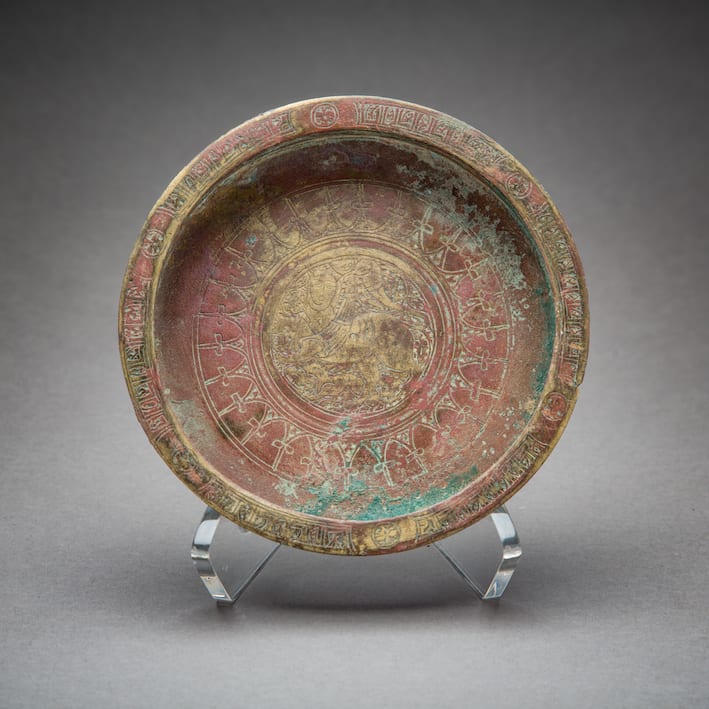Bronze Alloy Engraved Bowl, 12th Century CE - 13th Century CE
Quarternary Bronze
height 15.6 cm
height 6 1/8 in
height 6 1/8 in
LO.1012
This small dish features small sloping inwards sides engraved with a register of cursive script on the exterior, an everted rim also decorated with small foliage medallions and scroll bands,...
This small dish features small sloping inwards sides engraved with a register of cursive script on the exterior, an everted rim also decorated with small foliage medallions and scroll bands, and a slightly convex cavetto, the centre displaying a round medallion where an incised woman-headed winged lioness is graciously engraved, wearing a Khorasanian headdress, seen in profile looking three quarters at the spectator. This type of mythological sphinx appeared profusely from the 11th century onwards during the Seljuq period on Islamic metalworks and other media and, as an auspicious symbol, was mostly associated with the sun, the tree of life and life after death. It was only later during the 13th century, replaced by Chinese dragons and phoenixes in the repertoire of decorative arts.
This small plate was probably made of high tin bronze- an alloy of copper and about 20 per cent tin. This alloy was known in early Islamic times as asfidroy, literally 'white copper' and was used for bowls, stem bowls, dishes, ewers and candlesticks. amongst the particular properties of high tin bronze is that it can be red-hot forged, like iron, and if quenched, becomes reasonably malleable when cold. If permitted to cool slowly than hammered, it shatters. Three centres of quarternary bronze manufacture are recorded in Islamic texts of the 10th-11th centuries: Rabinjian near Bukhara, Hamadan in western Persia and Sistan province in eastern Persia. Transoxiana, i.e. Eastern Persia and Afghanistan, provided the inspiration for the Hamadan industry as well and kept on producing high-tin copper alloy vessels well into the 13th century, although with less originality than before.
The quality of engraving and the patterns featured on this dish would seem to support a 12th-13th centuries dating and a Transoxiana provenanc
This small plate was probably made of high tin bronze- an alloy of copper and about 20 per cent tin. This alloy was known in early Islamic times as asfidroy, literally 'white copper' and was used for bowls, stem bowls, dishes, ewers and candlesticks. amongst the particular properties of high tin bronze is that it can be red-hot forged, like iron, and if quenched, becomes reasonably malleable when cold. If permitted to cool slowly than hammered, it shatters. Three centres of quarternary bronze manufacture are recorded in Islamic texts of the 10th-11th centuries: Rabinjian near Bukhara, Hamadan in western Persia and Sistan province in eastern Persia. Transoxiana, i.e. Eastern Persia and Afghanistan, provided the inspiration for the Hamadan industry as well and kept on producing high-tin copper alloy vessels well into the 13th century, although with less originality than before.
The quality of engraving and the patterns featured on this dish would seem to support a 12th-13th centuries dating and a Transoxiana provenanc



